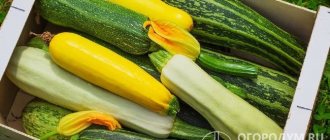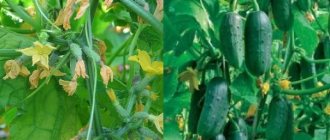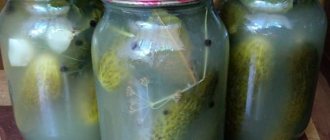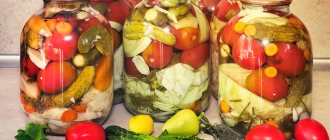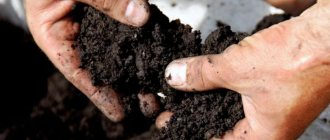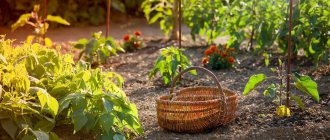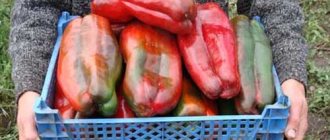Autumn is harvest time, for some crops the last of the year. But you want to eat fresh vegetables not only in the summer. If everything is done correctly, then until the coldest weather, crispy green cucumbers will delight the whole family, reminding them of the past summer.
It is appropriate to start preparing for growing cucumbers in a greenhouse in the fall at the end of summer. With the arrival of autumn coolness, the air temperature often no longer allows seedlings to develop in open ground. Already in September, everything should be ready for planting seeds, from which young shoots of cucumbers should soon grow. The first necessary step is preparing the greenhouse.
If any vegetables were grown in the greenhouse during the summer, then the ground must be cleared of remnants of leaves, shoots and roots.
The frame of the greenhouse can be wooden or metal. In any case, the frame material must be treated before planting seedlings: wood with a solution of bleach or water-based paint, metal with copper sulfate. This is done in order to protect future shoots from pests, rust and mold that can settle on the greenhouse frame.
The main materials used in greenhouses are film, glass or polycarbonate. Film is the simplest, but not the most durable type of coating. It is used more often for temporary summer greenhouse options. If you plan to plant cucumbers in such a greenhouse, then you need to carefully check the integrity of the coating and provide protection for young shoots from cold condensation, which always forms on the film in the morning. Because of this, plants can freeze and die.
A polycarbonate greenhouse is the most durable and reliable option, but such a structure costs a lot of money.
Therefore, it is not worth installing it for 3-5 kg of cucumbers. But if growing cucumbers in a greenhouse is a profitable business, then you should not skimp on a good polycarbonate greenhouse with heating, lighting and air ventilation.
Choosing a variety or hybrid for greenhouse cultivation
For this purpose, it is best to choose hybrid self-pollinating varieties, which include:
- Amur. The plant is medium-climbing, resistant to temperature changes and diseases. The fruits are oval in shape with a bumpy surface, length - up to 15 cm, weight - up to 120 g. Productivity - at the level of 20–25 kg/1 m².
- Suomi. The growth of side shoots is limited. The variety is resistant to cold and disease. Cucumbers are oval, up to 6 cm in length, dark green in color with light streaks. The surface is tuberculate with black spines. The lack of bitterness is genetically determined. Productivity - up to 30 kg/1 m².
- Valaamsky. The stem is powerful, practically without lateral lashes. The ripeness stage occurs after 38 days. The fruits are small, cylindrical, up to 6 cm in length, dark green with a waxy coating. Productivity - 13 kg/1 m².
- Sarovsky. The plant is single-stemmed. The cucumber is short, cylindrical, covered with tubercles with white spines. The weight of one fruit reaches 90–110 g. Productivity is 18-20 kg/1 m².
- Orpheus. Medium bushy variety. Fruits in 40 days after planting. The fruits are 13 cm long, the peel is thin with small tubercles, weight - up to 110 g. Productivity - 8-16 kg/1 m².
Preparing cucumber beds
Cucumbers are a semi-melon crop, so both in the greenhouse and in the open ground they need raised, high beds. It is better to form them in the fall, so that the constructed embankments can form their own microclimate and their own chemo-bio-environment. Remember that the top layer of soil should be well mixed and loose. Try to lay the beds so that organic additives (especially manure) do not lie in the open air; cover them thoroughly with soil. Under the ceiling of the greenhouse, pre-stretch the wire to which you will tie the cucumber vines.
Preparing the greenhouse for cultivation
First of all, it is necessary to remove the top 5 cm of soil after the harvest. This procedure will protect new plantings from harmful substances, pathogens and plant residues that have accumulated in the soil over the season. You should also put the structure itself in order: paint the frame and treat the metal elements with copper sulfate.
Fertilizers of mineral and organic nature must be added to the soil. Unrotted manure is ideal at a rate of 20 kg per 1 m². The soil sprinkled with fertilizer is dug up 25 cm deep.
Important! In the autumn, nitrogen fertilizers are contraindicated; they are applied only in the spring.
Then trellises are installed for subsequent gartering of bushes. The wire is fixed at a height of 2 m. The greenhouse must be equipped with heating devices so that the temperature is not lower than +22°C and the air humidity is at 80%.
In autumn, plants receive much less light, so it is necessary to install lighting sources that are fixed at a distance of 50 cm above the bush and raised as they grow.
Growing parameters
When growing cucumbers in the fall, inside the greenhouse it is necessary to create a microclimate suitable for good plant development. Cucumbers develop well at temperatures of 20-25 °C during the day and at least 15 °C at night. In any case, the difference in differences between day and night temperatures should not exceed 7 °C. Otherwise, the cucumbers will get sick, and their yield will be significantly reduced. The air temperature in the greenhouse should not fall below +10 °C. Otherwise, the cucumbers will turn yellow and die.
You shouldn’t heat the greenhouse too much. The air temperature should not rise above 35 °C. Otherwise, the cucumber pollen will become sterile, and the ovaries that have already appeared will stop developing, dry out and fall off.
The air humidity in the greenhouse when growing cucumbers should be 80%. Daylight hours with the help of lighting devices should be extended to summer levels. The lighting fixtures themselves should be placed at a distance of 30-50 cm from the tops of the plants. As the cucumbers grow and the vines rise along the trellis, the lighting fixtures need to be raised higher.
Planting methods
For planting, beds with a height of 20–30 cm are prepared. The holes are placed at intervals of 30–35 cm, this will allow the bushes to fully develop and ensure normal ventilation between them. The soil is irrigated before planting and after the moisture has been absorbed, the crop is planted.
For this type of cultivation, both seeds and pre-germinated seedlings are used. The seeding material is lowered to a depth of 2 cm, and as for the seedlings, a hole is formed with a depth corresponding to the size of the root.
How to prepare cucumber seeds for planting in the fall
Preparation in the fall consists of a set of measures aimed at changing its composition and structure according to the requirements of each plant. First, let's figure out what exactly is good for cucumbers. Having all the agronomic knowledge, you will be able to create all the necessary conditions for growing this vegetable.
Read about the best varieties of tall tomatoes for greenhouses at the link.
Soil requirements
The root system of cucumbers is very weak - one main root, tender and fragile. Therefore, fruits in winter require loose loamy soil, in which it will be easy for it to gain a foothold. An equally important indicator is acidity . The soil should be neutral or, at least, slightly acidic with a pH value of no more than 7 units. Because they are thermophilic, cucumbers take root well in multi-tiered beds containing several types of organic fertilizers (organic matter rots and warms the roots). It is also necessary to maintain the mineral composition, which includes nitrogen, potassium and magnesium.
Read about preparing a greenhouse for tomatoes in the fall here.
The looseness of the soil can be adjusted using regular sand. Otherwise, you can arrange a drainage system from coarse gravel and coarse organic waste (branches, twigs, but do not use sawdust and root shoots).
Predecessors
In some cases, other vegetable crops can partially prepare the soil for you. If you alternate different vegetables correctly and do not plant the same plants for more than 2-3 years in a row. Compliance with crop rotation ensures the preservation of soil structure and also prevents the transmission of diseases such as late blight. Cucumbers cannot be planted after similar plants, such as zucchini, melons (watermelons, melons), and pumpkins. Planting after nightshades is also unfavorable, especially after tomatoes have been planted in a polycarbonate greenhouse. They will grow well after early ripening white cabbage, root vegetables or peppers.
Soil preparation before planting crop rotation
The most favorable predecessors for any crop, including cucumbers, are legumes (peas or beans). These plants will provide the earth with nitrogen. You can sow it together with the main species, but in this case, do not allow the beans to overwhelm other vegetables.
Do-it-yourself soil fertilizers
Fertilization of fruits usually occurs in September. It can be done in the spring, but then the humus will not provide heating to the soil and planting will be delayed indefinitely. We begin this task after the harvest has been harvested and the greenhouse has been cleaned and disinfected. Check the condition of the structures; it is much easier to correct all problems before sowing.
The procedure for laying fertilizers:
- remove last year's soil to a hard sandy-loamy layer;
- Place some branches at the bottom of the beds (you can use pruned shoots of bushes and fruit trees);
- sprinkle such a “frame” of the bed with black soil;
- pour out manure at the rate of 1 bucket per square meter;
- lay down as much compost and humus as can be mixed with last year’s soil (shake it well to remove weed roots);
- the top layer should consist of 1:1 humus and ordinary loose sandy soil.
This layer cake will be an excellent help for growing cucumbers. During the winter, try to ensure that the prepared soil does not freeze. To do this, cover it with snow; this method will also help moisten the beds in the spring.
Despite the significant amount of fertilizer applied, do not forget about fertilizing. If your beds are based on a manure-compost bed, then the fertilizer should be mineral. In the first months of summer, alternate watering with potassium nitrate and wood ash tinctures.
Liming
As already mentioned, cucumbers need neutral or slightly acidic soil. It is necessary to lime the soil at elevated pH levels. If the pH is too high, then you will have to work with the chemical composition of your beds. Liming the soil will help you. The simplest and most affordable way is to scatter 200 g of quicklime per meter. A softer option is dolomite flour, poured into the soil in the same quantities. You can use wood ash, it must be taken at 300-350 grams per meter. Read about growing and caring for tomatoes in a greenhouse in this material.
Features of cultivation and care
Subsequent care for cucumbers is also important. A more detailed description of each parameter is provided below.
Temperature
From the moment of disembarkation, the temperature is kept at +25...+30°C during the day and up to +15°C at night. On sunny days, be sure to ventilate the room.
Watering
Plants need to be watered every other day. The procedure is carried out in the evening.
To do this, you should put a liquid spray nozzle on the hose, because strong pressure can damage the root system of the bush. On average, 1 m² will require about 8 liters of water.
Find out how to water cucumbers in a greenhouse correctly and how often.
Loosening
After watering, it is necessary to loosen the soil, this will increase its capacity for moisture and air. It is important to carry out the procedure carefully so as not to damage the rhizome, which is located in the top layer of the earth. At the same time, all weeds are removed, which takes away some of the nutrients contained in the soil.
Top dressing
The first application of fertilizers is carried out a month after planting and continues every 10 days.
For this use:
- ammonium nitrate;
- urea;
- ammophoska;
- superphosphate.
Formation of plants and garter
After the bush has grown to 30 cm in height and 4–6 leaves have formed on it, it can be tied up. Pinch out a plant up to 2 m high. To do this, the lower shoots are removed with pruning shears, the lateral shoots are cut off above the first leaf, and the top of the main stem is also cut off.
Familiarize yourself with the features of forming and gartering cucumbers in a greenhouse.
This procedure is aimed at ensuring that all energy is spent on the formation of fruits, and not on the growth of green mass.
Feeding cucumbers
To obtain a large and high-quality harvest, cucumbers in a greenhouse need feeding. It is important to ensure that the plant has enough nitrogen, which is in the soil. It is very simple to understand whether its concentration is sufficient. Pay attention to the leaves and fruits. If they are a lush green hue, the flowers bloom profusely, and the leaves and ovaries are of good quality, then everything is normal. With a lack of nitrogen, the leaves become yellow and the fruits become small.
Shrinking leaves, the appearance of blue veins, sparse fruits, leaf deformation - all these symptoms indicate various problems, in particular a lack of phosphorus, potassium, magnesium. If you notice that the plant lacks useful microelements, it should be fed. How it's done? To avoid such problems, you need to organize the first fertilizing a month after planting. And continue to feed the soil every 10 days.
Prevention of diseases and pests
The most common cultural diseases include:
- Downy mildew. The disease manifests itself as green and yellow oily spots on the surface of the leaves, which subsequently turn brown. Having discovered this, it is necessary to stop watering and fertilizing, treat the plants with a solution of copper oxychloride or Polycarbacin. After the procedure, you need to ventilate the greenhouse and prevent temperatures below +20°C during the day and +18°C at night.
- Powdery mildew. The green part becomes covered with a coating, becomes yellow-green, dries and curls. For treatment, the bushes are sprayed with a solution of potassium permanganate or mullein.
The plant is often attacked by pests:
- wireworms;
- mites;
- aphid.
Did you know? 1 kg of cucumbers contains only 150 kcal, which makes it an indispensable food product for those who want to lose weight.
To combat this problem use:
- "Confidor";
- "Decis-doublet";
- "Fury" 10%;
- "Zolon" 35%;
- "BI-58".
To reduce the likelihood of disease development and pest damage, it is necessary to clean greenhouses in a timely manner, maintain the distance between plantings and take into account the compatibility of crops before and during planting. Plant fall cucumbers in greenhouses starting in September, follow all the above recommendations and enjoy fresh vegetables all year round.
Protection from diseases
Planting autumn cucumbers involves protecting the sprouts from various types of infections. In addition, the humid and warm microclimate of the greenhouse is favorable for fungi, bacteria, microorganisms, and they lead to rotting of plants. Common diseases:
- Often seedlings are destroyed by the “black leg”, which affects the stem at the root. The fungus enters the greenhouse with the soil and multiplies rapidly in high humidity. For prevention, add wood ash to the soil.
- Various types of rot. For their treatment, special preparations are widely used, for example, the systemic fungicide Previkur.
- Powdery mildew. It appears as a grayish or white coating on the leaves. In greenhouses it spreads quickly in drafts. When the first signs appear, you need to spray the plant with mullein infusion: 1 tbsp. l. urea, 1 liter of mushy mullein, 10 liters of warm water. If the disease develops further, use the drug Topaz.
Why are cucumbers so popular?
As for cultivation, this vegetable is quite unpretentious and grows in a variety of conditions. His harvest is always quite large. The growing process is not as labor-intensive as, say, in the case of tomatoes. But at the same time, cucumber is popular because it quickly brings a feeling of fullness, without causing heaviness in the stomach and is easily absorbed in the body. With their help, the body absorbs protein faster and normalizes the general processes of the gastrointestinal tract. Cucumber is very low in calories. Therefore, it is considered an ideal product for those people who are overweight and on a diet. Well, last but not least, the cucumber is a very tasty vegetable. That's why it is in such demand.
Caring for cucumbers in a greenhouse
Cucumbers grow best in high humidity
Cucumbers grow best in high humidity (at least 80%). As long as the humidity is maintained, it is enough to water these plants once every two days. If the weather in autumn is quite warm, then you can water the cucumbers once a day. Water for irrigation should be at room temperature; fertilizers can be dissolved in it.
Cucumbers should be watered under the bush, being careful not to get on the leaves, as they may burn or rot.
Important: Plant growth requires oxygen, so the greenhouse should be ventilated 1-2 times a week, however, if the air temperature is too low, it is recommended to ventilate the greenhouse after covering the shoots with film.
About the benefits of late ripening cucumbers
Of course, for summer residents the simplest and most convenient solution is to grow early-ripening cucumbers. Many ultra-early hybrids delight with beautiful greenery after 35-40 days, so is it worth planting late varieties?
The secret lies in the characteristics of the culture, in the periods of plant development. The thing is that after planting in a permanent place, the cucumber begins to actively grow its root system and this happens before the first ovaries appear in the axils of the stem. After this, the bush directs all its energy to the formation of the stem and fruits, and the growth of the roots slows down slightly.
ON A NOTE! In early varieties and hybrids, fruiting occurs approximately 35-45 days after emergence.
The time for root development and growth in early cucumbers is significantly less than in late varieties. This means that the root system itself is smaller in volume, and it can provide much less nutrition for fruit-bearing bushes. Therefore, it often happens that early cucumbers, having pleased their owners with a bountiful harvest in July, begin to turn yellow and then dry out.
The options may be different, it all depends on the duration of fruiting of the variety or hybrid:
– extended fruiting with low yield of fruits;
– abundant harvest of fruits in a short time (“peak”) and completion.
Of course, proper feeding and care can extend the time frame a little, but in general the picture is exactly like this.
Properly preparing seeds for sowing
Previously, before germination, gardeners performed a procedure such as heating the seeds. This is long-term heating of dry seeds near heating devices at a temperature of 30-35 degrees.
Such events have a positive effect on increasing the formation of female flowers in all pumpkin plants.
When preparing self-pollinating and parthenocapic hybrids for sowing, the seeds do not need to be heated, since they do not have the problem of forming barren flowers.
Nowadays, seeds that have already been treated with thiram are often sold. Information is contained on the packaging. The seeds are colored poisonous green as a warning about the toxicity of the applied substance. Thiram is a fungicide that is used against a complex of diseases. Such seeds are not soaked or germinated.
If you have ordinary seeds, then they need to be treated with some kind of fungicide or a saturated solution of potassium permanganate. When there are many varieties, you need to put them in gauze bags and place them in the prepared solution for 15-20 minutes.
After this, you need to wash the seeds and start germination. Germination does not affect the yield, but avoids planting empty seeds.
Before germination, the seeds should be placed in a small amount of water for several hours or overnight to swell. The water should cover the seeds a little so that they do not “suffocate”. There is no need to harden cucumbers because they do not have the cold tolerance gene.
Advantages of the seedling method:
- allows you to get results earlier than when sowing seeds;
- the plant will grow and become stronger in comfortable conditions;
- sorting is possible: you can see which plants develop better and which worse;
- some seeds do not germinate immediately or freeze during seedling growth.
Plants of the same height will be easier to care for. The rest can be planted in a corner so that plants of the same type grow in one place. Such measures will allow you to get an early and healthy harvest.
